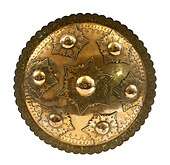Baluse
Baluse or Baloese is a traditional shield of the Nias people originating from Nias, an island off the west coast of North Sumatra, Indonesia. Baluse in the Northern Nias is somewhat smaller than those of the rest of the island.[1]
| Baluse | |
|---|---|
 A Baluse shield, pre-1942. | |
| Type | Shield |
| Place of origin | Nias, Indonesia |
| Service history | |
| Used by | Nias people |
| Specifications | |
| Width | 27 cm |
| Height | 120 cm |
Description
The shield is made of wood shaped like banana leaves and is held on the left hand which serves to deflect enemy attacks.[2] The surface of the shield is carved with rib-cage patterns from top to bottom. There is a round knob at the centre of the shield, and the shield's handle is directly behind this knob.[3]
Culture
The Baluse is used with the Balato (sword) or the Burusa (spear)[4] during traditional war dances such as Faluaya (or Fataele)[2] and Maena Baluse.[5]
gollark: There's some way to hide your VM's VMness from programs, isn't there?
gollark: I would probably just try and run it in a VM in some convoluted way (I'm sure it's possible).
gollark: Good, good.
gollark: Idea: just fake it by displaying a still image or something.
gollark: Apparently it just does this now, sad.
References
- Peter Suzuki (1959). The Religious System and Culture of Nias, Indonesia. Uitgeverij Excelsior. ASIN B0045VE6BY.
- "Tari Fataele: Tari Perang Khas Nias Selatan". Indonesia Tourism. Retrieved 7 April 2014.
- Albert G Van Zonneveld (2002). Traditional Weapons of the Indonesian Archipelago. Koninklyk Instituut Voor Taal Land. ISBN 90-5450-004-2.
- Arts of Asia (1990). Arts of Asia Volume 20 Number 2, March - April 1990. Arts of Asia. ASIN B002AR5BNM.
- Lucas Partanda Koestoro, Ketut Wiradnyana (2007). Megalithic Traditions In Nias Island. Medan Archeological Office. ISBN 979-98772-1-0.
Further reading
- Joachim Freiherr von Brenner-Felsach, Eine Reise nach Nias: unveröffentlichte Manuskripte aus dem Museum für Völkerkunde in Wien : Materialien zu Exotismus und Ethnographie, Böhlau Verlag Wien, 1998, ISBN 3-205-98959-7
This article is issued from Wikipedia. The text is licensed under Creative Commons - Attribution - Sharealike. Additional terms may apply for the media files.


